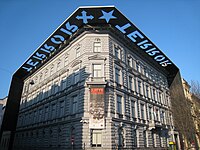House of Terror
This article needs additional citations for verification. (December 2023) |
Terror Háza | |
 House of Terror | |
 | |
| Established | 24 February 2002 |
|---|---|
| Location | Budapest, Hungary |
| Coordinates | 47°30′25″N 19°03′54″E / 47.5069°N 19.0651°E |
| Director | Mária Schmidt |
| Website | Official website |

The House of Terror (
The museum opened on 24 February 2002, and its director general has been Mária Schmidt.
The House of Terror is a member organization of the Platform of European Memory and Conscience.[1] Visitors including Zbigniew Brzezinski, Francis Fukuyama, and Hayden White have praised the institution.[2][3]
Building
The building was previously used by the Arrow Cross Party and ÁVH.
The museum was set up under the government of
During the year-long construction period, the building was fully renovated inside and out. The internal design, the final look of the museum's exhibition hall, and the external facade are all the work of architect Attila F. Kovács. The reconstruction plans for the museum were designed by architects
Permanent exhibition
The museum's permanent exhibition contains material related to the nation's relationships to
Much of the information and the exhibits are in Hungarian, although each room has an extensive information sheet in both English and Hungarian. Audio guides in English, German, Spanish, Russian, and Italian are also available.
The background music to the exhibition was composed by former Bonanza Banzai frontman and producer Ákos Kovács. The score includes the work of a string orchestra, special stereophonic mixes, and sound effects.

Controversy

Some historians, journalists, and political scientists such as Magdalena Marsovszky or Ilse Huber have argued that the museum excessively portrays Hungary as the victim of foreign occupiers and does not sufficiently recognise the contribution that Hungarians themselves made to the regimes in question.[4][5] Criticism has also been raised that far more space is given to the terror of the communist regime than the fascist one.[citation needed] One answer to these criticisms was that while the German occupation and fascist regime of Ferenc Szálasi lasted less than a year, the Hungarian Communist period lasted forty years. The museologists have also reminded critics that the Hungarian Holocaust has its own museum.[citation needed]
References
- ^ "Czech Prime minister Petr Nečas: The years of totalitarianism were years of struggle for liberty". Platform of European Memory and Conscience. 14 October 2011. Archived from the original on 30 March 2012. Retrieved 20 October 2016.
- ^ Kisantal Tamás, Krommer Balázs (2005). "Discussion with Hayden White" (PDF) (in Hungarian). Retrieved 10 November 2016.
- ^ "A Terror Háza honlapja". Archived from the original on 3 July 2008. Retrieved 9 November 2016.
- ^ Huber, Ilse. "Das Haus des Terrors in Budapest: Umstrittenes Museum über Ungarns Zeitgeschichte" (in German). Archived from the original on 12 July 2012. Retrieved 18 February 2011.
- ISBN 978-3-531-17191-3.


